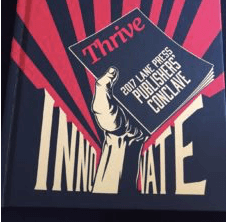I attended the inaugural Lane Press Publishers’ Conclave in 2016 and again this year, Oct. 25–27, at The Essex in Essex, Vermont, where around 100 magazine publishers, editors, and creative directors — Lane Press clients (like Convene) and non-clients — explored challenges specific to those in the media and print magazine business today.
Last year, after the Burlington, Vermont–based printer’s first time out of the gate hosting a conference, the company’s marketing specialist, Steve Marshall, and editorial director, Beth Renaud, got plenty of constructive feedback from attendees. While the evaluations were overwhelmingly positive, one comment kept cropping up: People wished there had been more structured opportunities to learn from each other.
So when planning this year’s event, Renaud searched for an instructional designer on fiverr.com, which bills itself as the largest freelance-services marketplace. She wanted to give the conclave’s nine presenters an expert resource to help them facilitate an interactive activity that would reinforce their message and get people to share with each other.
Renaud chose Finland-based workshop designer Katja Seppanen, who sees herself as “a concept and service designer with a love of storytelling,” she told me via email after the conclave concluded. “I provide a fresh pair of eyes to situations and come up with solutions, using customer-centric design methods.”
Looking at our work with a fresh pair of eyes was the focus of one of the exercises I participated in, which followed a session — “Good Luck With That: Upending a University Magazine” — by Wake Forest Magazine Editor at Large Maria Henson. We were asked to randomly select one image on a piece of paper from a group of them on our tables and allow it to spark an idea that we could use for our own magazines. We could come up with a story concept, for example, or a way to help convey an article’s message through illustration or typography.
The pictures themselves were difficult to describe — deliberately so, it turns out. “I selected images of nothing in particular that were deliberately ‘strange’ or ‘odd,'” Seppenan said. The photos couldn’t have appeared in other magazines, she said, “so there wouldn’t be any obvious answers, but they would force people to dig deeper for their inspiration.”
Seppanen and Henson settled on this activity after walking through Henson’s presentation together over Skype. “I wanted to know that if there was only one thing Maria could leave the audience with after the session, what would that be,” Seppanen said. “And I wanted also to have a feel for her personality — what kind of an activity was she looking for and felt comfortable facilitating. There was also the crowd size and time constraint to consider.“
The essence of Henson’s presentation was how you can draw inspiration from the most unlikely places, so the chosen activity “was all about making people abandon their boxes and wander outside a bit,” Seppanen said. They wanted people to think about how the image made them feel — “did it bring back a memory, was it a nice color scheme, an inspiring shape for a layout?” she said. “There were no wrong answers.”
Beyond Magazines
“We all get easily stuck in our ways of doing things, in some fields more than others,” Sappanen said. The exercise is an easy way to get people to “safely experiment with ideas, since it’s ‘just’ an activity.”
And it worked. Everyone at our table came up with a new idea for their publication. A university alumni magazine editor at my table was inspired by an image that looked like an assortment of objects, although we couldn’t make out what they were. It made her think of how she could take and publish photos of unusual collections and elements found in a much-loved, historic science building on campus before it was demolished to make room for a new structure.
As for me, I started to imagine how we could publish intriguing images from destinations that may make people look at those places differently. Perhaps a close-up of an element from an iconic structure or an unusual museum exhibit or special-event venue — so keep an eye out for how that may manifest itself on our pages and on this website!
Sappanen said that she had hoped that people would get “the strange picture in their hands and think ’What? I can’t use this!,’ but then end up surprising themselves when they came up with something anyway — and seeing others do the same,” she said. “And that proves the point concretely, in practice: You can draw inspiration from anywhere and anyone can do it. Hopefully that is something that sticks with people in the workplace as well.”
Presenters can help their messages stick with their audiences after events conclude, Seppanen said. When an audience hears something interesting at a session, they get “all pumped up and inspired,” she said. “And then they go back to their everyday lives.” It’s up to speakers, she said, to give them “something concrete and actionable” to take home.


